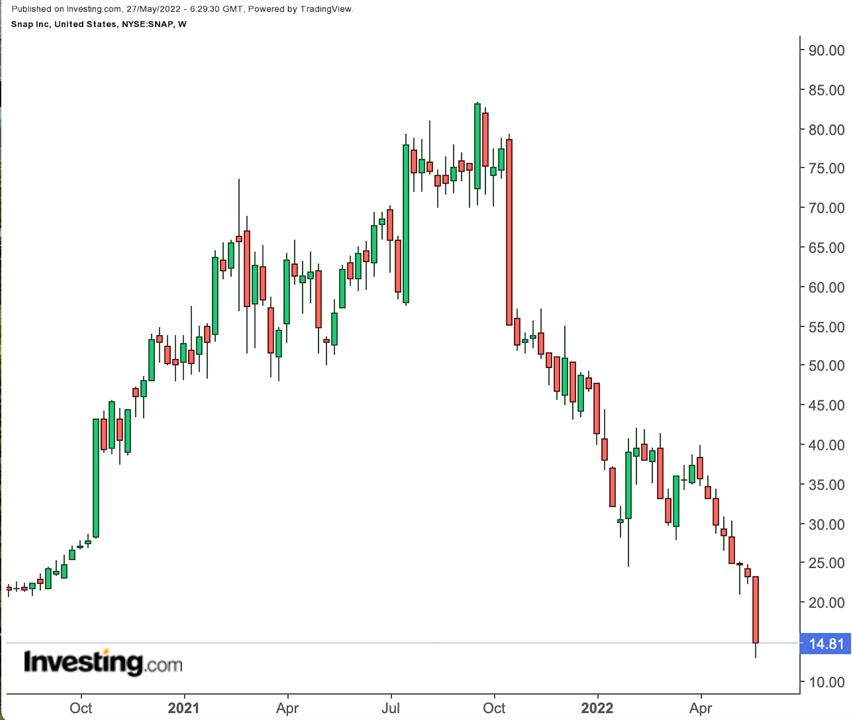- Snap plunged 43% on Monday, posting its biggest-ever daily drop
- So, is now the right time to buy?
- The social media app is facing sector-specific headwinds
-
If you’re interested in upgrading your search for new investing ideas, check out InvestingPro+
It’s been a roller-coaster ride for Snap (NYSE:SNAP) investors. Thursday, shares of the social media app closed at $14.81, roughly 13% below their initial public offering (IPO) of $17 and 82% below their 52-weeks high of $83.11, recorded on Sept. 24 last year.

Snap’s fall from grace reached a pivotal point earlier this week when the California-based company told investors it wouldn’t be able to meet its profit forecasts due to advertisers cutting their ad budgets—a sign of a worsening macroeconomic environment.
After the announcement, the stock plunged 43%, its biggest-ever one-day drop, erasing almost $16 billion in market value and completing the wipeout of all gains made during the last five years.
The bearish outlook also added to the declines of other social media giants, including Meta Platforms (NASDAQ:FB), Google-owner Alphabet (NASDAQ:GOOGL), and Twitter (NYSE:TWTR).
Chief Executive Officer Evan Spiegel said in a note to staff on Monday:
“We continue to face rising inflation and interest rates, supply chain shortages and labor disruptions, platform policy changes, the impact of the war in Ukraine, and more.”
The company’s regulatory filing later said:
“As a result, we believe it is likely that we will report revenue and adjusted Ebitda below the low end of our Q2 2022 guidance range.”
Snap's second-quarter revenue forecast, for 20% to 25% year-over-year growth, was already below analysts’ estimates.
A Buying Opportunity?
The plunge of this magnitude raised the question of whether this is a buying opportunity for growth-focused investors?
Undoubtedly, the COVID-19 pandemic played a significant role in increasing user numbers and swelling ad sales for smaller social media players as companies of all sizes turned to their platforms to reach customers who were stuck at home.
Spiegel and his team tactfully channeled this traffic boom into ramping up the app’s appeal to advertisers. The Snapchat app drew 332 million daily active users, 18% more than in the first quarter compared with the same period last year, with growth primarily coming from overseas. Sales during the period increased by 38% to $1.06 billion.
But the collapse in Snap share price isn’t just the apparent outcome of macroeconomic forces like high inflation, rising interest rates, and a war in Europe. Social media giants are also facing sector-specific headwinds, which will make it quite hard to produce the kind of double-digit growth to which many investors have gotten so used.
New rules from Apple (NASDAQ:AAPL) require all social media companies to get smartphone users’ permission for tracking, making it more difficult for advertisers to measure and manage their ad campaigns.
In addition to Apple privacy changes, the rise of Chinese-owned TikTok, with 2.91 billion monthly active users, plays a significant role in dampening Snap’s future growth plans. The service has attracted billions of teens globally, who are the bread and butter of Snap.
Highlighting these challenges, Dan Suzuki, deputy chief investment officer at Richard Bernstein Advisors, said on Bloomberg Television:
“[The companies] are having to bring these unattainable, unrealistic investors’ expectations back down to Earth. Underlying growth is slowing as these companies mature and become more competitive.”
Bottom Line
Snap shares are back to the level where they started before the pandemic. Given the sector-specific headwinds and the worsening macroeconomic conditions, both hurting the company’s ad revenues, there is a good chance they will languish there for quite some time.
***
Interested in finding your next great idea? InvestingPro+ gives you the chance to screen through 135K+ stocks to find the fastest growing or most undervalued stocks in the world, with professional data, tools, and insights. Learn More »
